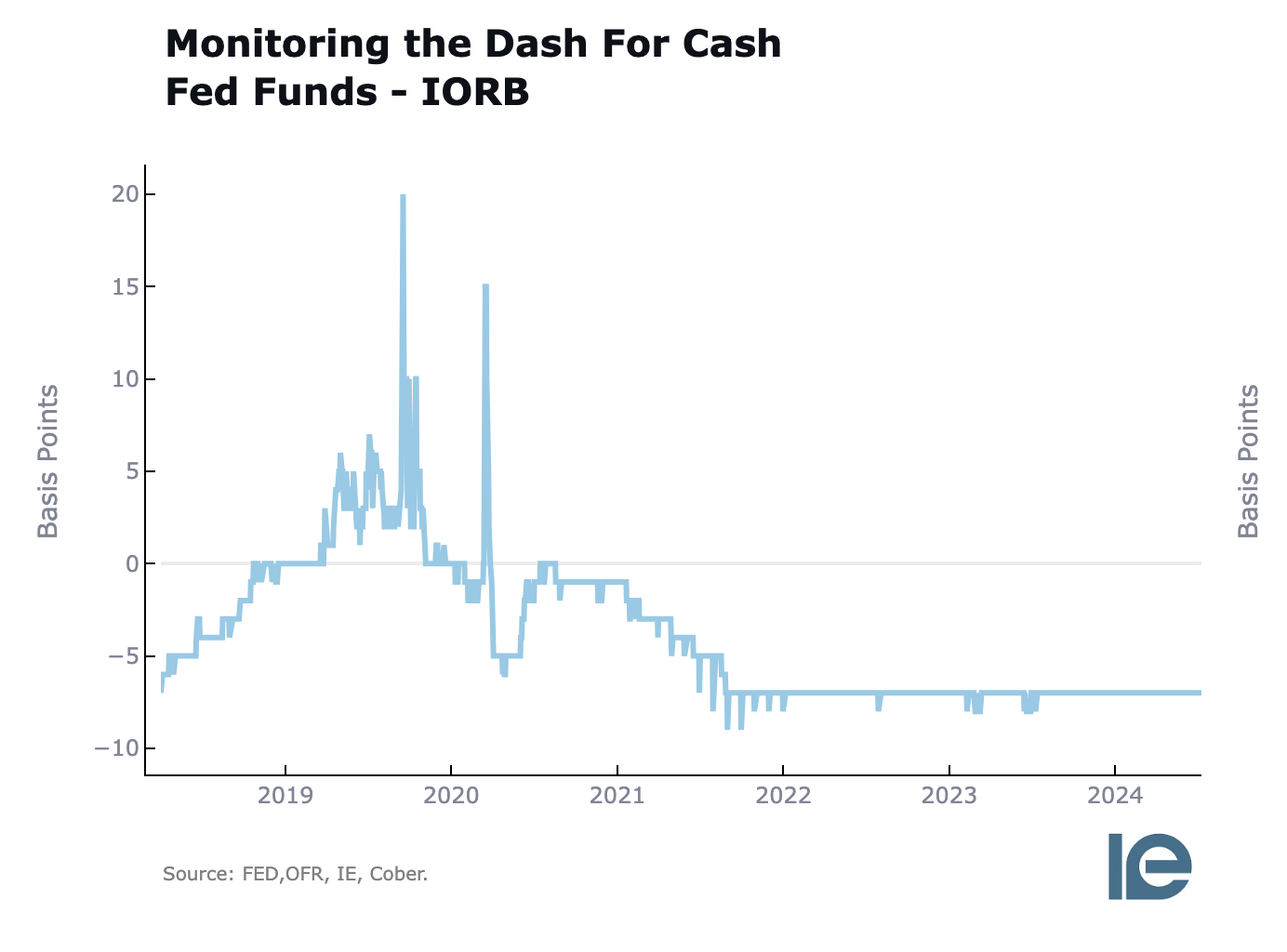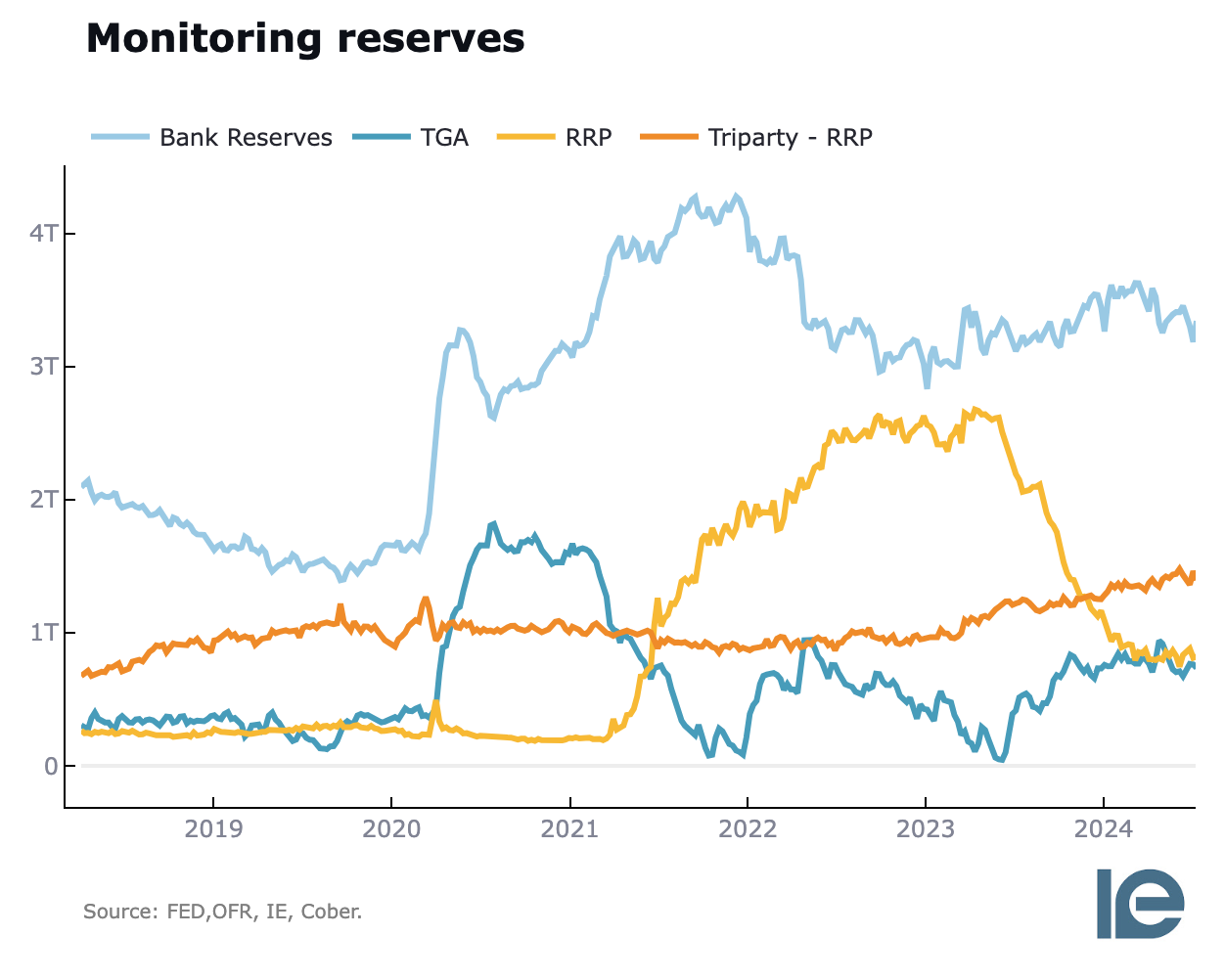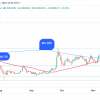Enjoy the On the Margin newsletter on Blockworks.co today. Get news delivered straight to your inbox tomorrow. Subscribe to the On the Margin newsletter.
Welcome to On the Margin, brought to you by Ben Strack, Felix Jovin, and Casey Wagner. Here’s what you’ll find in today’s episode:
- Checking short term interest rates and our current position.
- Ether ETFs hit the market today. Find out what we’re watching.
- Kamala Harris is close to securing the official Democratic nomination. Where do her top VP candidates stand on cryptocurrency?
A Deep Dive into Money Plumbing
The money plumbing, often referred to as short-term interest rates (STIR), is an esoteric world that is directly managed by the Fed. For the most part, the daily transactions in this part of the markets go unnoticed by the news media — that is, until something breaks.
The last time this happened was in September 2019, when the overnight repo market collapsed and repo rates rose sharply, as shown below in the spread between the federal funds rate and interest on reserve balances:

The reasons for this phenomenon are exotic and complex, but here’s the simple gist: The Fed’s ongoing quantitative easing had left the supply of available collateral (Treasury bonds) low enough that the repo market was left with too much cash chasing too little collateral, leading to a surge in demand that only the Fed could alleviate.
The Fed quickly opened its standing repo facility to allow repo dealers to swap their cash for collateral (Treasury bonds) in unlimited quantities. This also signaled the Fed to end its QT campaign and also signaled a shift toward a possible rate-cutting cycle.
This vignette shows how important it is to pay attention to this part of the market, especially if you want to understand when the Fed’s monetary operations might be impacted. With that in mind, let’s look at where we are today.
Note: All diagrams are taken from this Great free dashboard so you can track everything yourself!
Compared to September 2019, the current FFR-IORB spread is completely harmless, with no signs of accompanying stress. In fact, we are very far from anything breaking:

One of the key drivers of monetary stress is bank reserve levels. One of the most persistent ways to remove bank reserves from the system was QT, which led to an unwinding of the Fed’s balance sheet:

However, as the chart below shows, the vast majority of this reduction was offset by money flowing out of the RRP into the system, resulting in a slight decrease in reserve levels:

Here’s a quick overview of the STIR market at a superficial level:
- Despite the quantitative tightening that has been going on for almost two years, there are no signs of a shortage of bank reserves in the system.
- Reserves have not yet reached the “sufficient reserves” threshold that the Fed targets as a signal to end quantitative easing.
- Thanks to the Fed’s tough approach to the STIR market and its whack-a-mole approach to resolving any problems in the funding market, there is far less volatility and fragility in the system than there was in the previous QT cycle in 2018-2019.
— Felix Joven
345 dollars
This is Citibank’s new price target for Coinbase stock. The updated figure is 33% higher than the institution’s previous figure.
“Changes in the U.S. election campaign and the Supreme Court’s overturning of the long-standing Chevron precedent have changed our view of Coinbase’s regulatory risks,” Citi analysts wrote in a note on Monday.
ETH ETF Volumes (Unsurprisingly) Lagging BTC Debut
Nine Ethereum spot ETFs are now listed on U.S. exchanges. The landmark launches come six months after the debut of U.S. BTC spot funds.
Trading volumes in ETH products are not at the level of Bitcoin ETFs. But to be fair, no one we spoke to thought they (or the inflows) would be.
U.S. bitcoin products saw trading volumes on the first day (January 11) of trading at around $4.5 billion. Ether ETFs were lagging far behind that pace as of 1 p.m. ET, totaling nearly $600 million.
Bloomberg Intelligence analyst Eric Balchunas pointed to the data in a post by X. If the pace continues, trading volumes in $1 billion-plus ETH ETFs will be between 20% and 25% of the volumes in the BTC funds launched in January.
Grayscale’s more expensive Ethereum Trust ETF (ETHE) — with a 2.5% fee — has seen the highest volumes, at around $250 million. The crypto asset manager also has a “Mini” version of the trust, priced at 0.15%, which is the cheapest of its kind.
BlackRock’s iShares Ethereum Trust (ETHA) hit $127 million in volumes by 1 p.m. ET, second only to ETHE. By comparison, the asset management giant’s Bitcoin fund saw about $1 billion in trading volumes on its first day.
While volumes reflect the buying and selling of ETF shares, they do not yet give us an idea of the net flows of those funds.
Grayscale head of research Zach Pandl described the launch of ETH spot products as “low-key” compared to the “flashy” debut of their BTC counterparts. While investors may “underestimate” the importance of such products, Pandl added that he expects “significant” net inflows into ETFs in the coming months.
“These Ethereum spot ETPs are entering the US market at the same time as US policy changes towards cryptocurrencies and the adoption of tokenization by major financial institutions,” the executive noted.
Analysts and executives note that initial volumes and flows do not reflect the full picture of investor perceptions of these ETH funds.
But they tell the beginning of a story, and we watch it unfold.
— Ben Strack
Vice President Harris’ Short List
After her first full day of campaigning, Vice President Kamala Harris appears to have secured enough delegates to become the Democratic nominee, according to an Associated Press poll.
While Harris has kept her views on cryptocurrencies under wraps, several of her potential vice presidential candidates have taken more direct stances:
Roy Cooper
Cooper, who is completing his second term as governor, vetoed a bill in July that attempted to ban CBDCs in North Carolina. The state General Assembly passed the measure with broad bipartisan support. The vote ended with a 109-4 majority in the House and a 39-5 majority in the Senate.
Josh Shapiro
Earlier this year, grassroots environmental group Save Carbon County sued Shapiro and Stronghold Digital Mining for alleged pollution and abuse of tax credits. Environmentalists claim that under Shapiro, Stronghold and its subsidiary Panther Creek Electric Generating Facility received more than $20 million in Pennsylvania renewable energy tax credits.
Mark Kelly
Kelly was one of 12 Democratic senators who voted for Joint Resolution 109, a bill aimed at repealing the SEC’s personnel accounting bill 212. President Biden later vetoed the bill, and the House decided to uphold it earlier this month.
Andy Beshear
In 2021, Beshear signed into law two Kentucky bills that provided tax breaks to cryptocurrency miners. The legislative effort was intended to attract more mining operations to the state. It was successful, though not without controversy.
Pete Buttigieg
Buttedzieg, who himself ran for the White House in 2020, said years ago that Bitcoin should be “treated as a commodity.” That may have seemed revolutionary at the time, but today even SEC Chairman Gary Gensler has the same view on Bitcoin.
— Casey Wagner
Bulletin board
- Decentralized exchange dYdX is in talks to sell its derivatives platform, according to Bloomberg.
- As expected, Vanguard is not allowing clients to purchase the newly launched Ethereum ETF on its platform. The announcement comes after the company said in January that it would not offer a Bitcoin ETF either, citing volatility concerns.
- Coinbase CEO Brian Armstrong is no longer a member of the Giving Pledge, a global group founded by Bill Gates, Melinda Gates, and Warren Buffett to give away their wealth. Armstrong originally joined the pledge in 2018.
























